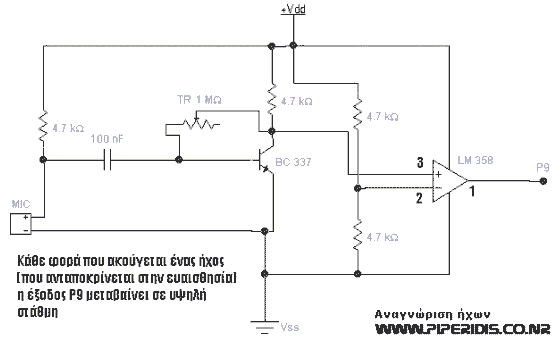
|
This is a simple circuit that can detect sounds by using a common condenser microphone. Sensitivity is variable . The circuit's output becomes High each time a sound is detected, otherwise it is in low level. You can use it in simple robots for sound responding (e.g. reaction -> when you clap your hands). This circuit recognize human voice as a common sound (you can't use it for voice recognition).
|
The circuit is very simple and has totally 3 stages:
- The microphone stage.
- The amplification stage.
- The comparator stage.
The microphone stage captures the sound and converts it to electrical signal. The amplification stage amplifies the signal and the comparator changes the output level if the amplified signal is higher from the reference voltage.
- A condenser microphone (like the common microphones for PCs).
- Four 4.7ΚΩ resistors (1/4 Watt).
- One 100nF capacitor.
- One BC 337 transistor.
- The OPAMP LM358.
- One 1ΜΩ pot
- A 8 pin DIP socket (for the LM358 chip).
- A small piece of a Veroboard
- Wire for connections
- Solder and soldering iron
Also you will need a stabilized 5 Volt external power supply. You can use a 4.5 Volt battery or even a 9 Volt battery. Be aware that with the 9 Volt battery the output level will be also at 9 Volt (not TTL logic).
Here is the schematic diagram of the simple sound detector with variable sensitivity (click on the picture to enlarge).
Attention: Vdd is the power supply (5 or 9 Volts). You can also use a 4.5 Volt battery. You adjust the sensitivity by turning the pot. The circuit can be extremely sensitive and can detect low sounds or even whispers.

No comments:
Post a Comment